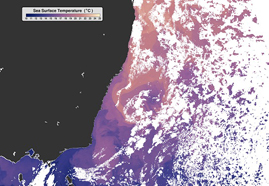Ocean "Hotspots" Warming 2-3 times Faster Than Global Average Rate
 Changes in global wind patterns have pushed the East Australian Current southward and warmed temperatures in the ocean off Tasmania by several degrees in the past few decades.
Changes in global wind patterns have pushed the East Australian Current southward and warmed temperatures in the ocean off Tasmania by several degrees in the past few decades.An ever-expanding network of sensitive measuring devices, including ocean buoys is enabling researchers to get a better handle on the magnitude and scale of global climate change, including a patterned emergence of ocean hotspots alongside currents that wash the east coast of the major continents.
The warming in those areas far exceeds the average rate of ocean warming, according to research published the journal Nature Climate Change this week.
“We would expect natural change in the oceans over decades or centuries but change with such elevated sea surface temperatures in a growing number of locations and in a synchronised manner was definitely not expected,” said Dr. Wenju Cai, of the Commonwealth Scientific and Industrial Research Organisation….
“Detecting these changes has been hindered by limited observations but with a combination of multi-national ocean watch systems and computer simulations we have been able to reconstruct an ocean history in which warming over the past century is 2-3 times faster than the global average ocean warming rate,” he added.
The changes are characterised by a combination of currents pushing nearer to the polar regions and intensifying with systematic changes of wind over both hemispheres, attributed to increasing greenhouse gases.
Cai said the increase of carbon dioxide and other greenhouse gases in the atmosphere has been the major driver of the surface warming of the Earth over the 20th century.
You can return to the main Market News page, or press the Back button on your browser.

